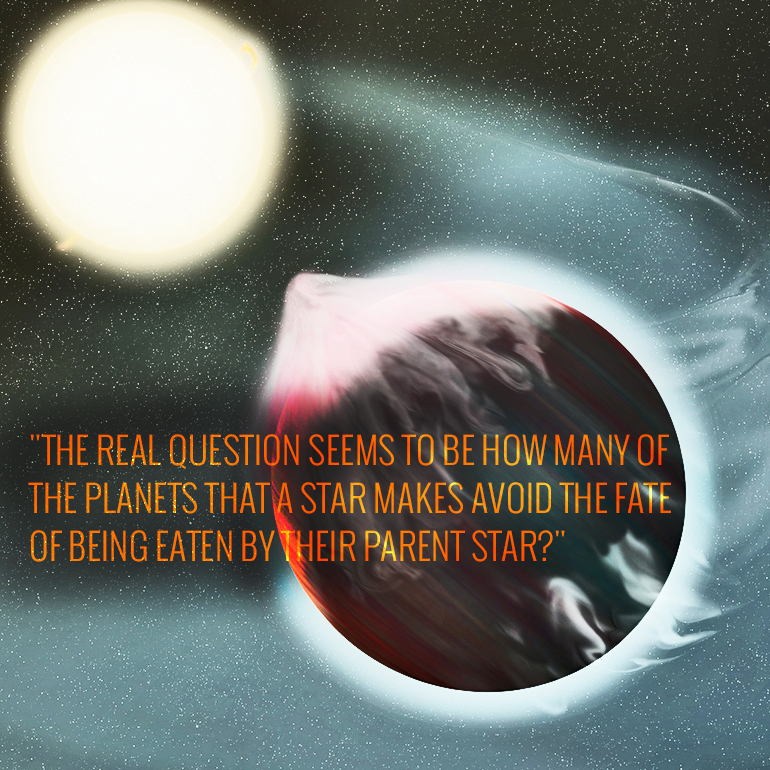What Happens to a Planet After It Is Swallowed by a Star?

"With the right corporeality of pulling and tugging, a gas giant can easily strength a rocky planet to plunge into the star. If enough rocky planets fall into the star, they volition stamp it with a particular chemical signature that we tin discover," says Trey Mack. (Credit: NASA/ESA/Thou. Bacon)
Some stars ingest material from rocky planets like Earth, and now astronomers have a way to study the consequence of such a diet on a star's chemical limerick.
The result is a new modeling technique that may assistance scientists identify Earth-like exoplanets.

To test the model, they focused on a pair of twin stars that both have their own planets. Both stars—designated HD 20781 and Hard disk drive 20782—are G-grade dwarf stars like to the Sun and both should have condensed out of the same deject of dust and gas—so they should have started with the same chemical compositions.
One star is orbited closely past two Neptune-size planets. The other possesses a single Jupiter-size planet that follows a highly eccentric orbit. The difference in their planetary systems make the two stars ideal for studying the connectedness between exoplanets and the chemical composition of their stellar hosts.
How the new method works
Stars consist of more than than 98 percent hydrogen and helium. All the other elements make up less than 2 percent of their mass. Astronomers accept arbitrarily defined all the elements heavier than hydrogen and helium every bit metals and accept coined the term "metallicity" to refer to the ratio of the relative abundance of iron to hydrogen in a star's chemical makeup.
[related]
Some scientists have argued that stars with high metallicity are more likely to develop planetary systems than those with low metallicity. One study suggested that hot Jupiter-sized planets are plant predominantly circling stars with high metallicity while smaller planets are found circling stars with a wide range of metal content.
In the current study, Trey Mack, a graduate pupil in astronomy at Vanderbilt University, took this type of analysis a stride further by looking at the affluence of 15 specific elements relative to that of the Sun.
He was particularly interested in elements like aluminum, silicon, calcium and iron that have melting points higher than 1,200 degrees Fahrenheit (600 degrees Celsius) because these are the refractory materials that serve as building blocks for Earth-like planets.
What the twin stars show
When Mack and colleagues analyzed the spectrum of the two twin stars, they found that the relative abundance of refractory elements was significantly higher than that of the Dominicus.
They also found that the college the melting temperature of a detail element, the college was its abundance, a tendency that serves as a compelling signature of the ingestion of Earth-like rocky material.
They calculated that each of the twins would have had to eat an additional 10 to 20 Earth-masses of rocky textile to produce the chemical signatures. Specifically, the star with the Jupiter-sized planet appears to have swallowed an extra ten Earth masses while the star with the two Neptune-sized planets scarfed down an boosted twenty.
A 'postage' that we can find
The results support the proposition that a star's chemical composition and the nature of its planetary organisation are linked.
"Imagine that the star originally formed rocky planets similar Earth. Further, imagine that information technology as well formed gas giant planets like Jupiter," says Mack. "The rocky planets grade in the region close to the star where it is hot and the gas giants form in the outer part of the planetary system where it is common cold.
"However, once the gas giants are fully formed, they begin to drift inward and, as they do, their gravity begins to pull and tug on the inner rocky planets.
"With the right amount of pulling and tugging, a gas giant can easily force a rocky planet to plunge into the star. If plenty rocky planets fall into the star, they will stamp it with a particular chemical signature that we tin can detect."
Following this logic, it is unlikely that either of the binary twins possesses terrestrial planets.
At one twin, the ii Neptune-sized planets are orbiting the star quite closely, at one-third the distance betwixt the Earth and the Sun. At the other twin, the Jupiter-sized planet spends a lot of time in the outer reaches of the planetary system simply information technology's eccentric orbit also brings information technology in extremely close to the star.
The astronomers speculate that the reason the star with the two Neptune-size planets ingested more terrestrial fabric than its twin was considering the 2 planets were more than efficient at pushing material into their star than the single Jupiter-sized planet was at pushing textile into its star.
If the chemical signature of Thousand-class stars that consume rocky planets proves to be universal, "when we find stars with similar chemical signatures, we will exist able to conclude that their planetary systems must be very different from our own and that they virtually probable lack inner rocky planets," says Mack. "And when we find stars that lack these signatures, then they are expert candidates for hosting planetary systems similar to our own."
"This work reveals that the question of whether and how stars form planets is actually the incorrect thing to inquire," says Keivan Stassun, an astronomy professor who supervised the study. "The real question seems to be how many of the planets that a star makes avoid the fate of being eaten by their parent star?"
The National Science Foundation supported the study, which was published in the Astrophysical Journal.
Source: Vanderbilt University
Source: https://www.futurity.org/happens-stars-eat-rocky-planets/